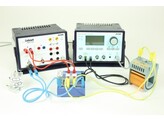Principle
In an RLC circuit, energy is exchanged periodically between a capacitor and a coil. When the electric field of the capacitor decreases by discharge over the coil, a magnetic field is established in the coil. As soon as the capacitor is completely depleted, the current flow through the coil vanishes. The magnetic field decreases again and the capacitor is charged, again. If this process could run loss-free, the energy would oscillate continuously between capacitor and coil with the resonance frequency, that is depending on the used components. The circuit is called RLC circuit because of the crucial physical properties, the inductance L of the coil, and the capacitance C of the capacitor.
Benefits
Voltage and current can be measured directly and simultaneously
Root mean square value displayed in real-time
Impedance will be computed in real-time
Fast and easy experimenting simply by switching components
Cost savings: oscilloscope functions integrated into the datalogging solution
Tasks
Measure the voltage drop over the LC component and the current through the circuit of a series-tuned and a parallel-tuned RLC circuit and determine the resonance frequencies.
Determine the impedance of the various RLC circuits.
Determine the bandwidth and the Q-factor from the resonance curves of the respective RLC circuit.
What you can learn about
Periodic oscillations
Damped oscillations
Forced oscillations
Kirchhoff's laws
Series-tuned circuit
Parallel-tuned circuit
Resistance
Capacitance
Inductance
Reactance
Impedance
Phase shift
Q-factor
Bandwidth
Operating system-independent software included. Computer not provided.
In an RLC circuit, energy is exchanged periodically between a capacitor and a coil. When the electric field of the capacitor decreases by discharge over the coil, a magnetic field is established in the coil. As soon as the capacitor is completely depleted, the current flow through the coil vanishes. The magnetic field decreases again and the capacitor is charged, again. If this process could run loss-free, the energy would oscillate continuously between capacitor and coil with the resonance frequency, that is depending on the used components. The circuit is called RLC circuit because of the crucial physical properties, the inductance L of the coil, and the capacitance C of the capacitor.
Benefits
Voltage and current can be measured directly and simultaneously
Root mean square value displayed in real-time
Impedance will be computed in real-time
Fast and easy experimenting simply by switching components
Cost savings: oscilloscope functions integrated into the datalogging solution
Tasks
Measure the voltage drop over the LC component and the current through the circuit of a series-tuned and a parallel-tuned RLC circuit and determine the resonance frequencies.
Determine the impedance of the various RLC circuits.
Determine the bandwidth and the Q-factor from the resonance curves of the respective RLC circuit.
What you can learn about
Periodic oscillations
Damped oscillations
Forced oscillations
Kirchhoff's laws
Series-tuned circuit
Parallel-tuned circuit
Resistance
Capacitance
Inductance
Reactance
Impedance
Phase shift
Q-factor
Bandwidth
Operating system-independent software included. Computer not provided.
Caractéristiques
- PP2440664
- P2440664

